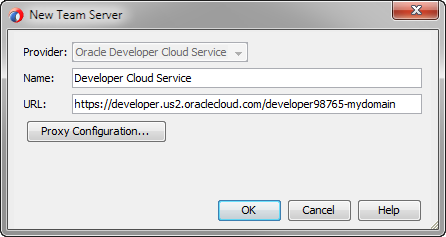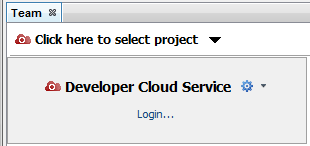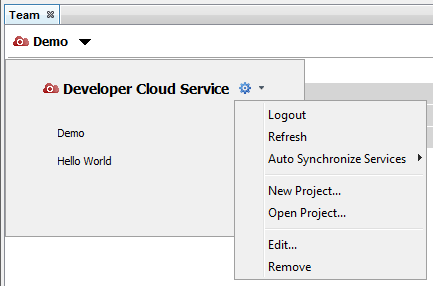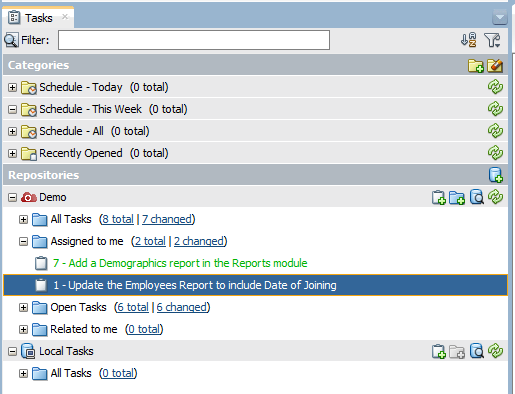JDeveloper
Oracle JDeveloper enables you to develop applications and commit the files to the Oracle Developer Cloud Service Git repository. JDeveloper also uses the Team Server plugin to access DevCS projects. The plugin is installed by default in JDeveloper.
Use the Team Server
From the Team tab, you can access DevCS projects, create a project, search a project, access its Git repositories, issues, and builds.
Using the Configure ![]() menu, you can create or open a project, or logout of DevCS.
menu, you can create or open a project, or logout of DevCS.
| Action | How To |
|---|---|
|
Open the project’s dashboard |
The project’s dashboard lists the recent activities and builds of the project. To open the Dashboard, in the Team tab, click Dashboard. |
|
Open the project in the web browser |
In the Team tab, click Project Web. |
|
Create a DevCS project |
Click Configure |
|
Open a project |
Click Configure |
Create a DevCS Project in JDeveloper
You can create a DevCS project in JDeveloper and then push it to Oracle Cloud. You can also push an existing JDeveloper project to an empty repository of a DevCS project Git repository.
Open a DevCS Project in JDeveloper
You can open an DevCS project in JDeveloper and update its source code files.
Use Git in JDeveloper
Using the Team menu or the Versions tab, you can commit files, create and merge branches, and push changes to the hosted Git repository.
For more information about Git actions in JDeveloper, read the Versioning Applications with Source Control chapter of Oracle Fusion Middleware Developing Applications with Oracle JDeveloper on http://docs.oracle.com/middleware.
Watch a short video to learn more about using Git in Oracle JDeveloper.
This table describes some common actions you can perform to manage Git repositories from the NetBeans IDE.
| Action | How To |
|---|---|
|
View Git repositories of a project |
In the Team tab, expand the Sources node. |
|
Access branches of a cloned project Git repository |
From the Team menu, select Versions. Expand the repository node and then the Branches node to see local and remote branches. |
|
Checkout a branch |
Expand the Branches node, right-click the branch, and select Checkout. |
|
Create a branch |
Expand the Branches node, right-click the base branch, and select Create Branch. In the Create Branch dialog box, enter a branch name, configure other options, and click OK. |
|
Add a file to index |
In the Applications tab, select the file. From the Team menu, select Git, and then select Add. |
|
Commit files |
Select the IDE project in the Applications tab and then from the Team menu, select Git, and then select Commit. In the Commit dialog box, enter a message, verify the commit files, author and commiter, and then click Commit. |
|
Push commits to the project’s Git repository |
Select the IDE project in the Applications tab. From the Team menu, select Git, and then select Push. |
You can download the Git extension from the Help menu. Open the Help menu and select Check for Updates. See the JDeveloper documentation for more information.
Manage DevCS Issues in JDeveloper
In JDeveloper, you can manage DevCS issues, create issues, update issues, and create a search query.
JDeveloper displays tasks in the Tasks tab. To open the tab, from the Window menu, select Tasks.
This table describes some common actions you can perform to manage issues from JDeveloper.
| Action | How To |
|---|---|
|
View issues of the project |
In the Tasks tab, expand Repositories. In the project name’s node, expand the filter to view its issues. By default, the Tasks tab displays issues of these filters:
|
|
Open and update an issue |
In the Tasks tab, double-click the issue. The issue’s details display in a new tab of the IDE. Update the issue’s properties and click Submit. |
|
Create an issue |
In the Tasks tab, select the project node, right-click, and select Create Task. Enter the details and click Submit. The issue is automatically synchronized with the DevCS project is available to other project members. |
|
Create a query |
In the Tasks tab, select the project node, right-click, and select Create Query. In the Find Tasks tab, enter the search criteria and click Save Query. |
Associate an Issue with a Commit
When you commit files, you can associate an issue with a commit.
- In the Tasks tab, open and update the issue that you want to associate with the commit.
- From the Team menu, select Commit.
- In the Commit dialog box, enter the commit’s message and verify the files.
- In the Update Task section, select the issue from the Task list.
- Select the desired resolution check boxes and the commit option.
- Click Commit.
Monitor a Project’s Builds in JDeveloper
The Team tab displays all builds and jobs of the project along with their status.
To view a particular build's details, double-click the job name in the Team tab to view its builds in the web browser.
Build Oracle ADF Applications
You can develop Oracle ADF applications in JDeveloper and then build them using OJMake and OJDeploy tools with Ant or Maven in DevCS.
Build ADF Applications with Ant
Use OJServer with OJDeploy
When you run a job configured to use multiple OJDeploy builds, the build starts, runs, and then shuts down JDeveloper ojdeploy for each invocation. You can increase the OJDeploy performance by using OJServer, which eliminates the requirement to start and stop OJDeploy after each invocation.
To use OJServer with OJDeploy, you must configure the job and update the Ant script to use OJServer.
Build ADF Applications with Maven
You can configure the Maven POM file to access the Oracle Maven Repository to access JDeveloper and ADF libraries. You’d also need Oracle SSO credentials to access the Oracle Maven repository.
- Create an Oracle ADF application in Oracle JDeveloper.
- Add and configure the Maven POM file of the ADF application. Use the DevCS build executor environment variables to access OJMake, OJDeploy, and the Oracle Maven Repository.
- Commit and push the application to the hosted Git repository.
- In DevCS, create and configure a job with a Maven build step.
- Run a build of the job to generate the artifacts.



